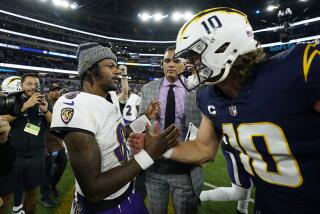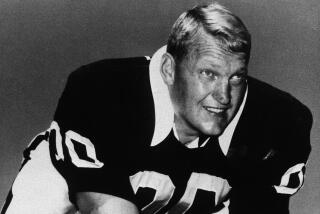COMMENTARY : Best-Ever Quarterback: Make It Joe Montana
- Share via
Joe Montana, the best quarterback ever, worked with physical gifts that can’t be measured. He never could explain how he did his astonishments, nor could anyone be taught to do what he did: He made decisions without thought. He saw things and knew what they meant without stopping to consider the possibilities.
The great British race car driver, Stirling Moss, nearly died in a wreck and came back two years later to drive at record speeds--only to retire the day he drove faster than he ever had.
He said he quit for a good reason: “I had to think.”
He had to think of when to brake, when to shift, when to turn. He found himself thinking of the speed necessary to do what he once did without thought. The magic of instinct had been replaced by the mechanics of thought.
Stirling Moss had won Formula One races touching the brakes and shifting gears a thousand times without knowing he did those things. He had become the car. When he became the car’s passenger, it was time to quit.
Larry Bird with a basketball in hand knew where the other nine men soon would be. He knew without knowing how he knew. On the run, he stole the Isiah Thomas pass and without a dribble threw a no-look pass to Dennis Johnson sprinting to the hoop. Maybe he had seen Johnson a second before; maybe he knew everyone would be running his way; maybe he knew he had to throw it to that place because only from there could the game be won--and somebody would get there, somehow, because he would lead them there with the pass.
But how could anyone know so much so quickly? How could Joe Montana do it? How did he find Dwight Clark at the back of the end zone? How did he find John Taylor over the middle against the Bengals?
Here’s how.
Jerry Rice is going deep. Montana is dropping back, two steps, three, and he sees Rice has drawn two defenders his way. So he looks for a second receiver, maybe a tight end.
From looking deep, he now is looking short and Montana sees the tight end tangled in a blur of colors behind the line of scrimmage. Which means Montana will make a short toss to a man out of the backfield.
All these decisions made while dropping back. All in two seconds. All while gliding back so gracefully that former coach Bill Walsh called him poetry in motion. All done so quickly that analyst John Madden said, “With most guys, it’s ‘I see. I step. I throw.’ With Montana, it’s ‘Iseestepthrow.’ ”
To appreciate the wonder of such work, we should listen to the old quarterback Joe Theismann, himself a Super Bowl winner, now ESPN’s NFL commentator: “Joe could survey the whole field looking for 1 and if 1’s not there, he’s going to 2 and if 2’s not there, he’s going to 3 or 4, just click-click-click-click, like a computer.
“To me,” Theismann says, “Joe symbolizes everything you can do without a real strong arm. To start with, he had great command of his offense. He played in the same system all 15 seasons. Just total command.
“He had great patience, especially on his play-action passing. He was seven years my junior in the league, but I studied his play-action on film. Sometimes you just want to hurry up and fake and throw it. Not Joe. He had patience and discipline.
“He had toughness. He came back from back surgery and elbow surgery and knee surgeries. Steel Curtain defense. Joe won with the same offense, but with different support groups around him.”
Theismann’s summary:
“Joe Montana is the greatest quarterback ever to play professional football. The total package.”
He could run it downfield. He could throw it hard or soft, on the line or floating, and cause it to arrive between Jerry Rice’s numbers. He could put it there on the run. Relentless in his precision, he could score in 16 plays or, if necessary, in one. Under the gun he raised his considerable talents to levels inspiring to see. He came to a huddle not with a swagger but with a certain inevitability: He had done this before, he would do it again. Men who breathed his air became better than they knew they could be.
Small wonder, then, that one of the NFL’s rising star quarterbacks, Brett Favre of the Green Bay Packers, began his professional education three years ago by studying videotapes put together by his coach, Mike Holmgren, once the San Francisco 49ers quarterback coach.
More to Read
Go beyond the scoreboard
Get the latest on L.A.'s teams in the daily Sports Report newsletter.
You may occasionally receive promotional content from the Los Angeles Times.










